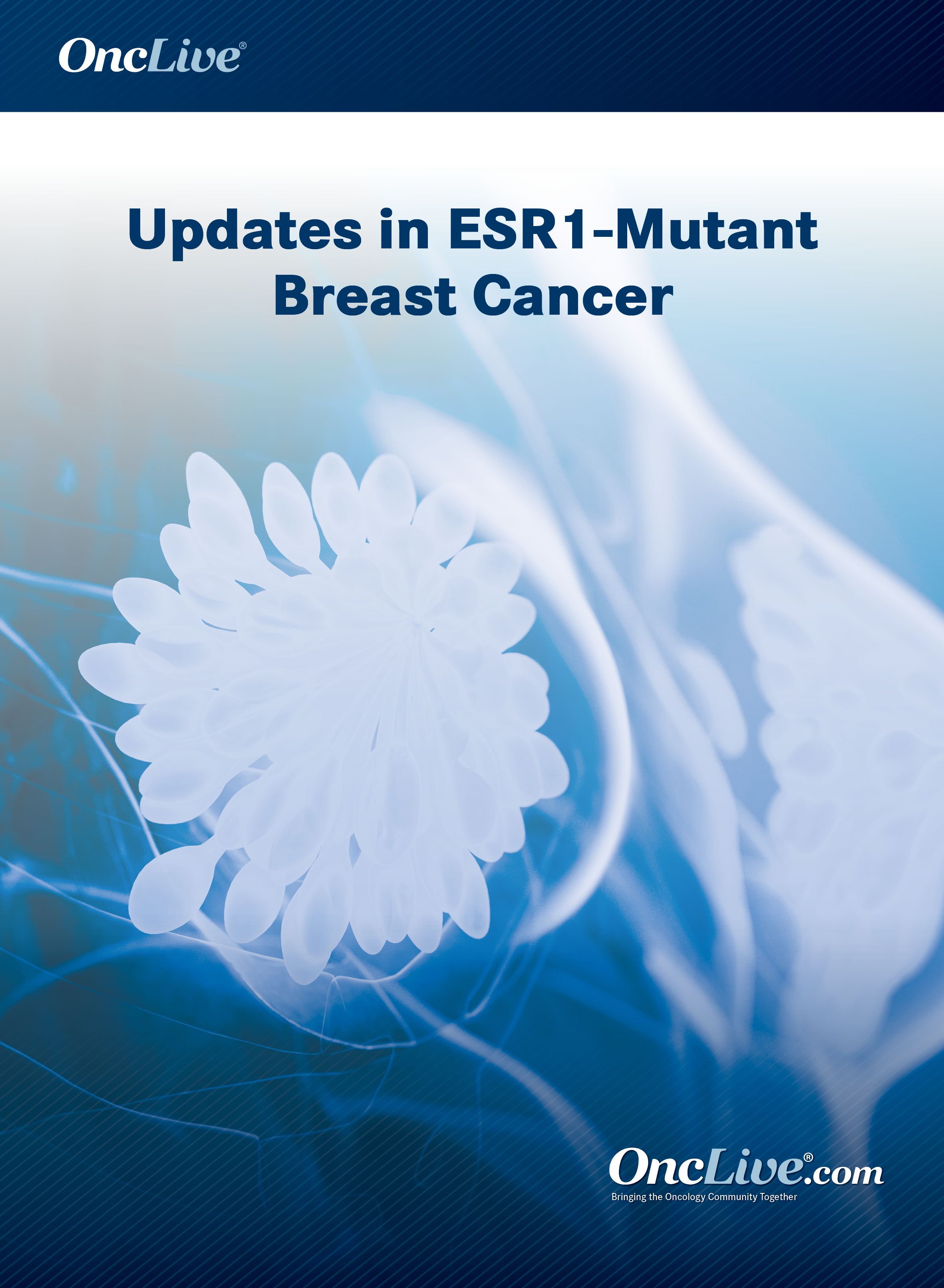Parsing Out Remaining Questions With CDK4/6 Inhibitors in HR+ Breast Cancer
Sarah Sammons, MD, discusses the clinical significance of ESR1 mutations in HR-positive, HER2-negative breast cancer, how to determine the optimal timing to perform genetic sequencing for ESR1 mutations, and emerging agents, like lasofoxifene, that are poised to transform the paradigm for patients who harbor these mutations.
Sarah Sammons, MD

CDK4/6 inhibitors, such as palbociclib (Ibrance), abemaciclib (Verzenio), and ribociclib (Kisqali), added to fulvestrant (Faslodex) have been welcome additions to the treatment paradigm for patients with ESR1-mutant, hormone receptor (HR)–positive, HER2-negative metastatic breast cancer, said Sarah Sammons, MD. However, novel therapies are needed to improve upon the limited survival benefit these agents plus endocrine therapy confer.
“Certainly, if we identify a patient who has an ESR1 mutation that has progressed on a first-line aromatase inhibitor [AI], the addition of a CDK4/6 inhibitor to fulvestrant is strongly recommended,” said Sammons.
“As an endocrine therapy backbone, fulvestrant is the best we have right now, but we need to do a lot better. A lot of work is ongoing in this population to figure out the optimal treatment for patients. Right now, oral SERDs [selective estrogen receptor degraders] and a few SERMs [selective estrogen receptor modulators] are promising,” Sammons explained.
In an interview with OncLive®, Sammons, an assistant professor of medicine in the Department of Medicine and a member of the Duke Cancer Institute at Duke University School of Medicine, discussed the clinical significance of ESR1 mutations in HR-positive, HER2-negative breast cancer, how to determine the optimal timing to perform genetic sequencing for ESR1 mutations, and emerging agents, like lasofoxifene, that are poised to transform the paradigm for patients who harbor these mutations.
OncLive®: What significance do ESR1 mutations confer and how frequently are they identified in patients with breast cancer?
Sammons: ESR1 mutations are most commonly missense mutations that happen in the ligand binding domain of the estrogen receptor. They lead to constitutive activation of the receptor in a ligand-independent fashion. ESR1 mutations occur in up to 40% of patients who have advanced HR-positive, HER2-negative breast cancer after exposure to AIs in the advanced setting.
ESR1 mutations are uncommon in primary HR-positive breast cancer; they occur in less than 1% of primary tumors. In patients who have been exposed to adjuvant AIs and still have estrogen-sensitive disease, ESR1 mutations are fairly rare; about 3% to 5% of the first relapse of metastatic disease will have these mutations. These mutations happen later on in the metastatic course, after exposure to and progression on AIs.
It is important to note the clinical significance of ESR1 mutations. In many retrospective and prospective series, ESR1 mutations have been shown to denote resistance to AIs. A recent study by Nicholas Turner, MD, PhD, [of The Institute of Cancer Research] looked at circulating tumor DNA [ctDNA] in patients from the SoFEA and EFECT trials comparing fulvestrant with exemestane. [The study] clearly showed that patients who had detectable ESR1 mutations in their ctDNA had inferior progression-free survival [PFS] and overall survival [OS] when they were treated with exemestane. They did much better when they were treated with fulvestrant.
There is an ESR1 mutation that appears to be resistant to fulvestrant as well. The Y537S mutation is one of the more common mutations. The PALOMA-3 ctDNA analysis showed that mutations in Y537S were likely to occur in the fulvestrant [plus] CDK4/6 and fulvestrant [plus] placebo arms. [The investigators] concluded that this is potentially a resistance strategy for fulvestrant. Several other very strong preclinical studies have shown that Y537S is resistant to fulvestrant.
We have [some time] to go. Some new treatments, such as oral SERDs and lasofoxifene, look more promising for the specific clone. It will be interesting to see how that pans out.
When is it clinically practical to sequence for ESR1 mutations? How does the presence of an ESR1 mutation affect your treatment decisions?
Some practitioners will sequence all advanced patients at first relapse. However, that is not my practice. At this time, my practice is to sequence patients after they have progression on CDK4/6 inhibition with endocrine therapy in the first-line setting. The reason for that is there can be targetable mutations that can be acquired over the period of receiving CDK4/6 inhibitors. Sequencing patients prior to first-line therapy rarely changes my practice pattern for patients who have endocrine-sensitive disease. For patients who have de novo metastatic disease, or their disease has occurred greater than 1 year after adjuvant therapy, we give standard-of-care treatment with an AI and a CDK4/6 inhibitor.
The PARSIFAL trial was presented this past year and showed that [the combination of] an AI and CDK4/6 inhibitor was not inferior to fulvestrant and a CDK4/6 inhibitor in up front. This confirmed and made us feel better about using [AIs plus CDK4/6 inhibitors] in the first-line setting.
Interesting, PADA-1 is a clinical trial that has been looking at ESR1 mutations in the estrogen-sensitive population. These are the de novo patients or patients who relapsed more than 1 year after adjuvant therapy. Thus far, [investigators] found that ESR1 mutations are rarer in this population, occurring in about 3% of patients. Despite it only being 3%, those who have ESR1 mutations up front in the ctDNA did have inferior PFS to an AI plus a CDK4/6 inhibitor; the median PFS was around 11 months versus 27 months.
Interestingly, ctDNA dynamics also seemed to matter. If a patient had a baseline ESR1 mutation and they were started on an AI and CDK4/6 inhibitor and they were able to eliminate that clone early in their treatment course—which is about two-thirds of patients—patients did just as well as those who didn’t have [an ESR1 mutation] at baseline.
We still have further work to do, and PADA-1 is also looking at what to do in those patients who don’t clear their ESR1 mutation in the ctDNA or those who develop ESR1 mutations while they are on an AI and CDK4/6 inhibitor. Should we be changing their endocrine backbone to fulvestrant?
At this time, for the majority of patients with estrogen-sensitive HR-positive, HER2-negative breast cancer, an AI and a CDK4/6 inhibitor are still the first-line answer. For patients who progress on adjuvant AIs, we are still recommending fulvestrant and CDK4/6 inhibition based on the landmark clinical trials that looked at that. We know that in that population of patients who progress on first-line AIs that an ESR1 mutation will be present in about one-third of patients. Do those patients with ESR1 mutations respond as well to CDK4/6 inhibitors added to fulvestrant as those who are wild type for ESR1? ctDNA analyses were performed in almost all of the landmark trials looking at fulvestrant and CDK4/6 inhibition, including the MONARCH, MONALEESA, and PALOMA trials.
Luckily, we have found that patients who have ESR1 mutations derive substantial benefit from the addition of a CDK4/6 inhibitor. Therefore, the answer is that patients who have baseline ESR1 mutations still derive great benefit from adding a CDK4/6 inhibitor to abemaciclib, palbociclib, or ribociclib. In the MONARCH-2 clinical trial, ctDNA analysis showed that patients with ESR1 mutations derived a greater benefit from the addition of a CDK4/6 inhibitor compared with those who had wild-type ESR1.
Do you consider switching CDK4/6 inhibitors for patients who progress on one?
The question is, really: Is there efficacy in CDK4/6 inhibitors after progression on CDK4/6 inhibitors? The short answer is that we don’t know from a well-designed, prospective clinical trial yet. There are anecdotal reports and retrospective data showing that abemaciclib may have some activity after progression on palbociclib, but we need more research.
Several clinical trials are ongoing looking at the efficacy of CDK4/6 inhibitors post CDK4/6 inhibitors. Certainly, we would imagine that the endocrine therapy backbone would be changed. If a patient received an AI and palbociclib in the first-line setting, looking at the efficacy of fulvestrant and abemaciclib in the second-line setting would be an intriguing approach.
What therapies are on the horizon for patients with ESR1-mutant disease?
A lot of work is ongoing [trying to] determine the optimal endocrine therapy backbone for these patients. We know that fulvestrant monotherapy in this population has a median PFS of around 4 months, so we would certainly like to do better. Many oral SERDs are being explored in early- and late-phase clinical trials as single agents and in combinations with CDK4/6 inhibitors and other targeted therapies. Oral SERDs may have an advantage over fulvestrant because fulvestrant, given as an injection, has fairly poor bioavailability. The hope is that oral SERDs will have improved bioavailability and therefore improved efficacy. There are a variety of [investigational oral SERDs] out there and we are excited about a few of them. Preclinical work has shown that they seem to be superior to fulvestrant in treating ESR1-mutant HR-positive breast cancer. We are [far away from showing], in clinical trials, whether [oral SERDs] will truly be superior to fulvestrant. We also don’t know what their adverse effect profiles will be in comparison with fulvestrant. Fulvestrant is very well tolerated from a safety standpoint, so understanding whether oral SERDs will be superior [in terms of efficacy] and will have a good enough safety profile to give as alternatives to fulvestrant is a question that I hope we are able to answer within the next couple of years.
Another compound that seems to have preclinical activity in ESR1-mutant breast cancer is the lasofoxifene. Lasofoxifene versus fulvestrant is currently being explored in the phase 2 ELAINE trial in patients with ESR1-mutant breast cancer who have progressed after a CDK4/6 inhibitor and endocrine therapy. Patients could not have had prior fulvestrant. This trial is ongoing, and we are certainly excited to see the results of it. Then, the ELAINEII trial is looking at lasofoxifene plus abemaciclib in a similar patient population.




